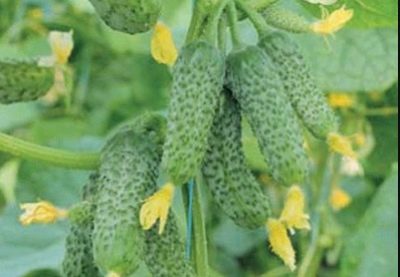
- Authors: NUNHEMS B.V.
- Year of approval: 2000
- Growth type: indeterminate
- Fruit weight, g: 90-100
- Fruit length, cm: 9-12
- Fruit color: dark green with light stripes and small rounded spots
- Cucumber Mosaic Virus Resistance: stable
- Ripening terms: early
- Pollination: bee-pollinated
- Fruit shape: cylindrical
Cucumber Ajax, as you might guess from the sonorous name in honor of the hero of the Trojan War, is another hybrid bred by Dutch breeders. It is recommended for cultivation in all regions and is included in the Russian State Register. This is one of the first hybrids of imported origin imported into Russia. Since that time, it has been invariably popular with domestic gardeners. Its advantages are early ripening, presentable appearance and intended use for harvesting for the winter.
Breeding history
It was received in Holland at the end of the last century, and at about the same time it appeared in Russia. A well-known privately owned seed company that has been breeding for many years. Cucumber Ajax is obtained by crossing two species, but their names are kept secret by the producers, and this is understandable. The hybrid retains the obtained valuable properties only in the first generation. By collecting seeds at home, you can grow a pumpkin representative, but completely different. Therefore, gardeners are forced to purchase plant seeds annually from an official representative of a Dutch agricultural firm.
Import origin, cross-border transportation and customs duties make them expensive, but the results are worth every penny invested.
Description of the variety
Ajax cucumber can be grown in small plots for your own needs and for commercial profit. This is a strong plant, in the description of which its valuable features are invariably mentioned:
indeterminacy, which does not limit growth, branching, which makes it the best option for trellis growing;
the possibility of cultivation in open ground and in greenhouse conditions (hence the recommendation for any region, even with a cold climate);
great taste and high yield;
transportability (when transported over long distances, it retains a presentable appearance and aroma, is resistant to mechanical damage);
immunity to common diseases of cucumbers;
a small number of barren flowers, all the rest of the female type, certainly give an ovary.
The high yield is due to the appearance of fruits in almost every leaf sinus. As a disadvantage, gardeners note pollination by insects, which makes greenhouse cultivation somewhat troublesome. Outdoors - unpretentious to weather conditions and undemanding to care, except for the need to install trellises or use cucumber nets.
Characteristics of the appearance of plants and zelents
The hybrid variety is distinguished by a strong bush with intensive branching and no growth restrictions. Leaves of medium size are somewhat wrinkled, but of a beautiful intense green color. In each leaf axil there is a bunch of bright yellow flowers, 2-3 pieces each. Beautiful greens are formed from them.
Cylindrical gherkins, dark green in color, with small stripes of a lighter shade, the skin is dense and crunchy, covered with small thorns,moderately tuberous. All fruits are approximately the same size, which makes them attractive to the buyer. The variety is optimal for canning for the winter.
Purpose and taste of fruits
Taste is the main, but not the only advantage of Ajax cucumbers. Dense and juicy pulp, filled with sweetish juice, a small amount of seeds, no cavities, pleasant aroma and persistent aftertaste are the reasons for the profitability of its industrial breeding.
The versatility of use assumes eating fresh and in any salads, preservation for the winter - pickling, pickling, assorted vegetables. The ability to bear fruit before frost makes it easier for housewives to prepare delicious fruits for the winter that will help get rid of vitamin deficiencies in the cold season. This is also facilitated by the size (diameter up to 3 cm, length - 10-12 cm, weight up to 90 g).
Maturation
Fruits can be harvested within a month and a half after germination. After the end of fruiting, lateral branches begin to give greens on the main lash. The harvest ripens together, which makes it easier to harvest. Long-term storage does not affect either the presentation or taste.
Yield
The average is indicated - 4.9 kg per sq. m, but this is not the limit. Correct agricultural technology, the use of special supporting devices increase the chances of getting an excellent result in industrial breeding. You have to collect greens every day.
Growing and caring
The seeds do not require processing, so they can be planted for seedlings without wasting time. If planted in a garden bed, you need watering and mulching. The main stem is directed up the trellis, they can be chosen from the proposed industrial types or made on their own. Watering and feeding is carried out according to the standard scheme, the only difference is that organic matter is introduced a week after the start of fruiting. Fertilizers can be applied together with drip irrigation. Watering is necessary every three days, it is better to do this in the evening, using water heated by the sun during the day.

In order to collect strong, tasty and beautiful cucumbers on your site, you need to make top dressing. Lack of nutrients can negatively affect the appearance of the plant and significantly reduce the yield. Fertilize cucumbers with organic fertilizers in combination with mineral fertilizers. With the right balance of these components and adherence to the fertilizing schedule, the cucumber yield will be maximum.

Despite their popularity, cucumbers are often attacked by diseases and pests. From them, cucumber plantings often die before the start of fruiting. In order to prevent this from happening, it is necessary to try to prevent ailments or get rid of them at the very beginning, having studied in detail their causes of occurrence, signs and methods of treatment.





























































































